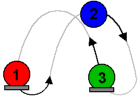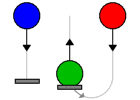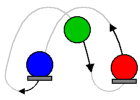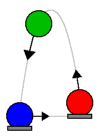

Balls and Beanbags are the basic juggling prop. Although you can juggle just about anything, inexpensive sets of balls specifically designed for juggling are readily available, and ideal for beginners. Juggling balls are usually seed-filled, and have the feel of a firm beanbag, making them easy to throw and catch. Normal beanbags are sometimes used as a cheap alternative. The Three Ball Cascade
This is the most basic juggling pattern possible. If you want to learn, follow the four steps below. You may also find our juggling software section helpful.
 Two ball exchange. Hold one ball in each hand, and throw the ball in
your right hand as you did in step one. As this ball reaches its peak
throw the ball in your left hand in a similar fashion. Your left hand
will now be empty to catch the first ball. Once you caught this ball,
catch the second ball your right hand. The two balls have now swapped
over: this is called the two ball exchange. Make sure that the second
ball is thrown on the inside of the one coming down: this should help
avoid collisions later on. The two balls should not be thrown at the
same time; the second ball needs to be thrown after the first. Also,
be sure make the second throw as high as the first; don’t be tempted to
pass it straight across to the right hand.
Two ball exchange. Hold one ball in each hand, and throw the ball in
your right hand as you did in step one. As this ball reaches its peak
throw the ball in your left hand in a similar fashion. Your left hand
will now be empty to catch the first ball. Once you caught this ball,
catch the second ball your right hand. The two balls have now swapped
over: this is called the two ball exchange. Make sure that the second
ball is thrown on the inside of the one coming down: this should help
avoid collisions later on. The two balls should not be thrown at the
same time; the second ball needs to be thrown after the first. Also,
be sure make the second throw as high as the first; don’t be tempted to
pass it straight across to the right hand. The Cascade. Start with two balls in the right hand, and one in the
left. Throw the first ball in the right hand and the one in the left
as in the two ball exchange. You should find the second ball heading
towards the right hand. Now throw the third ball (to make way for the
second ball to be caught) in the same way as the first ball. Continue
in this fashion; throwing each ball to make way for the one in the air
to be caught. All the throws should be the same; thrown from one hand
to the other, peaking at about eye-level. The throws should be made on
the inside, the catches on the outside.
The Cascade. Start with two balls in the right hand, and one in the
left. Throw the first ball in the right hand and the one in the left
as in the two ball exchange. You should find the second ball heading
towards the right hand. Now throw the third ball (to make way for the
second ball to be caught) in the same way as the first ball. Continue
in this fashion; throwing each ball to make way for the one in the air
to be caught. All the throws should be the same; thrown from one hand
to the other, peaking at about eye-level. The throws should be made on
the inside, the catches on the outside.The three ball cascade is only the tip of the iceberg; there are plenty more tricks to get your teeth into. Some of the more common possibilities are given below:
 Start with two balls in the right hand, and one in the left. Throw one
ball from the right and one from the left simultaneously and straight
up. As these two balls peak, throw the third ball straight up in the gap
between them. Catch the two balls coming down and throw them up together
as before. Continue in this fashion.
Start with two balls in the right hand, and one in the left. Throw one
ball from the right and one from the left simultaneously and straight
up. As these two balls peak, throw the third ball straight up in the gap
between them. Catch the two balls coming down and throw them up together
as before. Continue in this fashion.
The balls are thrown in twos and ones as in columns. However, instead of throwing the pair throw together straight up, throw them diagonally, so that they cross over mid-air, and are caught in the opposite hand.
 Three balls are juggled as in the cascade. Instead of throwing every
ball on the inside of the one coming down, one ball is selected, and
each time it is thrown, the throw is made from the outside. The throw
is made higher than normal so it travels over the top of the pattern,
and is then caught on the outside as normal. The overall effect is to
have this ball (the tennis ball) travelling over the top of the other
two balls which perform a small figure of eight (the net) below.
Three balls are juggled as in the cascade. Instead of throwing every
ball on the inside of the one coming down, one ball is selected, and
each time it is thrown, the throw is made from the outside. The throw
is made higher than normal so it travels over the top of the pattern,
and is then caught on the outside as normal. The overall effect is to
have this ball (the tennis ball) travelling over the top of the other
two balls which perform a small figure of eight (the net) below.
 As in Jugglers’ Tennis this involves a wide throw (and catch) on the
outside of the pattern. However instead of throwing one ball in this way,
one hand always throws like this while the other makes smaller throws
underneath. The result is that the three balls all follow the same path,
going round in a rather distorted loop.
As in Jugglers’ Tennis this involves a wide throw (and catch) on the
outside of the pattern. However instead of throwing one ball in this way,
one hand always throws like this while the other makes smaller throws
underneath. The result is that the three balls all follow the same path,
going round in a rather distorted loop.
 This pattern is the natural extension to jugglers tennis and the half
shower. This time, every single throw is made on the outside of the
ball which is about to be caught. As its name suggests, this is the
standard cascade pattern juggled backwards. For some reason, most people
find it less natural, and hence more difficult than the cascade. You
will probably need to adjust your throws to make the balls land more
towards the centre than normal, so you have room to throw the next ball
comfortably on the outside.
This pattern is the natural extension to jugglers tennis and the half
shower. This time, every single throw is made on the outside of the
ball which is about to be caught. As its name suggests, this is the
standard cascade pattern juggled backwards. For some reason, most people
find it less natural, and hence more difficult than the cascade. You
will probably need to adjust your throws to make the balls land more
towards the centre than normal, so you have room to throw the next ball
comfortably on the outside.
 In this trick, the three balls all follow the same path going round in a
continuous cycle. The right hand (say) throws the balls much higher than
usual to the left hand. As soon as each ball lands in the left hand it
is passed across to the right hand ready to be thrown again. The best
way to lean this trick is to start with two balls in the right hand and
one in the left. Start by throwing bother the balls from the right hand
up high and in quick succession. As soon as the second ball has been
thrown, the third ball (still in the left hand) must be passed across
quickly into the right hand. All this must happen before the first ball
lands – you now get an idea of how high/fast the throws need to be. As
the first ball is caught in the left hand, the right hand must throw the
last ball in the same way as the first two. The quick ‘catch-pass-throw’
sequence is then repeated to keep the balls circulating. In siteswap
notation the shower is 5 1.
In this trick, the three balls all follow the same path going round in a
continuous cycle. The right hand (say) throws the balls much higher than
usual to the left hand. As soon as each ball lands in the left hand it
is passed across to the right hand ready to be thrown again. The best
way to lean this trick is to start with two balls in the right hand and
one in the left. Start by throwing bother the balls from the right hand
up high and in quick succession. As soon as the second ball has been
thrown, the third ball (still in the left hand) must be passed across
quickly into the right hand. All this must happen before the first ball
lands – you now get an idea of how high/fast the throws need to be. As
the first ball is caught in the left hand, the right hand must throw the
last ball in the same way as the first two. The quick ‘catch-pass-throw’
sequence is then repeated to keep the balls circulating. In siteswap
notation the shower is 5 1.
Juggle the cascade as normal, and then throw one of the balls a bit higher than usual. The next ball is then thrown under your leg; the higher previous throw is to give you a bit more time. With some practice the unusual throw can be made to come down in about the right place to continue without disrupting the cascade pattern. Be sure to lift your leg nice and in good time. Try each leg, and whether you throw from the inside or the outside. Different people will find different combinations easier than others.
Exactly the same as under the leg above, except that the unusual throw is made behind your back. It’s best to practice without juggling first, to see how to make the throw. Start with a single ball in one hand and your lower arm horizontal and out in front of you. Then let your lower arm drop to straight down by your side, and then swing it up behind your back. You’ll have to judge for yourself when to release the ball, which you should aim to have passing over the opposite shoulder and coming down to be caught comfortably in the other hand. When you’ve mastered this, it’s just a matter of trying to put it into the cascade!
These tricks are very satisfying to perform, but are rather complicated to describe. The best thing to do is to ask someone who can already do them, and look at a computer animation (preferably in slow motion).
This is the basic four ball pattern. It’s really cheating because two balls are juggled in one hand, and two in the other – they don’t cross over. Practice juggling two balls in one hand. Make them go round in ‘circles’, being thrown up on the inside and coming down on the outside. When you can do this consistently with both hands on their own try putting it together. The throws from each hand can either be made simultaneously (synchronous fountain), or for a better effect you can stagger them, thus throwing alternately from each hand (asynchronous fountain).
The standard five ball pattern is essentially the same as that for three balls. The hands throw alternately, and to the opposite hand. However it is much harder since at least three balls must now be in the air at any one time, so the throws must be faster and/or higher. Both of which lead to problems with accuracy.
The basic pattern for any even number of balls is the fountain: that is half the balls are juggled in each hand, without crossing over. So six (or eight) balls are juggled in the same way as four, but with higher/faster throws so that three (or four) can be done in each hand. The basic patter for odd numbers of balls is the cascade. The same pattern used for three and five balls is followed, but with higher/faster throws being needed. Good luck!